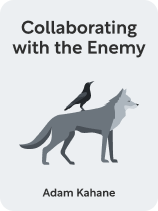

This article is an excerpt from the Shortform book guide to "Collaborating with the Enemy" by Adam Kahane. Shortform has the world's best summaries and analyses of books you should be reading.
Like this article? Sign up for a free trial here.
Have you ever found yourself stuck in a project with people you don’t agree with, like, or trust? How does stretch collaboration differ from traditional collaboration?
In Collaborating with the Enemy, conflict resolution expert Adam Kahane offers an unconventional approach to working with difficult people. Kahane’s “stretch collaboration” framework shows how to embrace both conflict and connection, experiment with different solutions when the path ahead isn’t clear, and focus on changing your contribution rather than trying to change others.
Keep reading to learn strategies for transforming seemingly impossible collaborations into productive partnerships.
Collaborating with the Enemy Book Overview
As our social world becomes increasingly volatile, uncertain, complex, and ambiguous, the ability to collaborate across deep divides has become an essential skill, but conventional approaches to collaboration often fail precisely when we need them most. Whether in corporate teams navigating conflicting priorities, communities addressing contentious social issues, or international groups working on complex global challenges, we frequently find ourselves needing to work with those we might consider adversaries.
Collaborating with the Enemy (2017) tackles a fundamental challenge we all face: how to work effectively with people we don’t agree with, like, or trust. Adam Kahane, drawing on his 30+ years as a global conflict mediator, presents an unconventional approach called “stretch collaboration” that lets you embrace conflict, experimentation, and personal change rather than pursuing artificial harmony, rigid planning, and attempts to change others.
Kahane’s expertise comes from facilitating high-stakes collaborations around the world. He has worked with governments, corporations, and civil society organizations, witnessing what makes collaboration succeed or fail in complex, contentious situations. Kahane observes that the path forward in such complex situations is rarely straight or clear. It emerges as we walk it together, even with those we initially see as obstacles rather than allies. Stretch collaboration gives us the principles and practices to navigate this uncertain terrain, turning potential enemies into partners in creating new realities.
In this guide, we’ll explore Kahane’s framework for working with others effectively even when mutual agreement, trust, or affinity are absent. First, we’ll define stretch collaboration and how it differs from conventional approaches. Then, we’ll dive into the three core strategies that make this approach work: embracing both conflict and connection, experimenting with solutions through an adaptive, iterative process, and changing your own collaborative contribution rather than trying to change that of others. We’ll also explore how these principles apply across different contexts—from community organizations to clothing design workshops—and how Kahane’s ideas connect to Buddhism’s imperative to transcend your own perspective.
What Is Stretch Collaboration?
As our world becomes increasingly interconnected through globalization, technology, and social media, we encounter more people with different values, interests, and perspectives. These connections span our workplaces, communities, and political environments, and they create situations in which we must collaborate with people we don’t agree with, like, or trust. For these challenging situations, Kahane introduces “stretch collaboration” as an alternative to traditional approaches.
He explains that traditional collaboration typically assumes three things: that we must focus on harmony and suppress conflict within the team; that we must agree on a detailed plan before taking action; and that we can change what others are doing if we try hard enough. While these assumptions might work in simple situations with like-minded people, Kahane explains that they fail in complex, contentious environments for three reasons.
First, traditional collaboration methods demand an unrealistic level of harmony when stakeholders have fundamentally different interests and worldviews. Attempting to suppress these differences creates an artificial sense of unity that inevitably fractures. Second, they insist on detailed planning before action, which becomes impossible when participants cannot reach consensus on goals or methods. This leads to paralysis or superficial agreements that lack commitment from all those involved. Third, they assume we can change others’ behavior, which breeds frustration and blame when we find we can’t control how other people act.
Additionally, Kahane explains that we often worsen contentious situations by treating others as adversaries who must be eliminated or excluded, and not simply as people we disagree with. This polarization makes conventional collaboration impossible.
Kahane says that stretch collaboration addresses these limitations by requiring us to move beyond our comfort zones in three specific ways:
- Acknowledge both differences and connections. Rather than forcing artificial harmony, we must recognize conflicts while also building genuine relationships.
- Adopt an adaptive, iterative approach. Instead of insisting on agreement about a predetermined plan, we should try different possibilities through a process of testing and learning.
- Focus on changing your contribution. We should direct our energy toward changing our own behavior rather than trying to change others.
This approach recognizes that in complex situations, we can’t control what happens, but we can influence it through our participation. It requires us to hold seemingly contradictory ideas in tension: We must assert our interests while engaging with others, and we must accept the situation as it is while working to change it. Stretch collaboration enables us to balance our priorities and work with others in situations where conventional collaboration would break down.
How to Use Stretch Collaboration
Now that we’ve explained what stretch collaboration is and why traditional approaches often fail, let’s explore how to put Kahane’s principles into practice. Adopting a stretch collaboration approach requires three fundamental shifts in how we work with others, especially those we see as adversaries. Let’s examine each of these principles in depth.
Principle #1: Acknowledge Both Differences and Connections
First, Kahane explains that effective collaboration requires both embracing conflicts and nurturing relationships. He contends that all human interactions are shaped by two fundamental drives: the drive for power and the drive for love. The drive for power motivates us to seek self-realization and opportunities to assert our individual interests. We express this when advocating for our perspective, pushing for our needs to be met, and maintaining our independence. On the other hand, the drive for love motivates us to seek connection and unity with others. This emerges when we listen, find common ground, and prioritize collective well-being.
Kahane contends that most of us overemphasize one drive at the expense of the other, with negative effects on our ability to collaborate effectively. People who focus primarily on power create fragmentation and resistance; those who focus primarily on love suppress important differences and create artificial harmony. This artificial harmony manifests as superficial agreements that lack real commitment, unaddressed tensions that inevitably resurface, and a false sense of consensus that masks genuine differences.
With stretch collaboration, we alternate between the drives for love and power rather than trying to hold them simultaneously, giving both conflicts and connections the space they need to be fully understood. Sometimes you need to assert your position forcefully; at other times, you need to step back and engage with others’ perspectives.
Kahane explains that in complex collaborations, conflicts aren’t just inevitable; they’re necessary. They arise from genuine differences in perspectives, interests, and values that we need to acknowledge. Without surfacing these differences, we miss opportunities for creative solutions that could emerge from the productive engagement of diverse viewpoints. At the same time, without connection, conflicts become destructive rather than generative. Connection provides the trust necessary to engage honestly with differences, the resilience to weather disagreements without breaking apart, and the shared context that makes collaborative action possible.
Practical Steps to Facing Conflicts and Making Connections
Kahane recommends taking four steps to effectively acknowledge both differences and connections.
1) Recognize and articulate conflicts openly. Name tensions and disagreements directly but without inflammatory language. Distinguish between positions (what people say they want) and interests (why they want it). Create spaces where differing perspectives can be safely expressed.
2) Build genuine connections across these differences. Share personal stories that reveal why issues matter to you. Actively listen to understand others’ experiences and motivations. Find areas of common concern amid disagreement.
3) Practice alternating between asserting and engaging. When the group is stuck in conflict, intentionally shift toward connection. When artificial harmony prevails, deliberately bring tensions to the surface. Pay attention to which drive (power or love) you tend to overuse, and consciously balance it.
4) Recognize that each participant represents their own “whole” (organization, community, or perspective). Avoid privileging any single whole as more important than others. Create space for multiple perspectives to interact without requiring them to merge.
For a real-world example of Kahane’s first principle in action, imagine a suburban neighborhood committee that’s divided over development plans: some want a traditional park with a bandstand, others want a modern recreation center, and a third group advocates for a shopping plaza. Rather than forcing consensus, they convene at the community hall where each faction explains their priorities—preserving green space, providing youth activities, and bringing convenience to the growing suburb.
When discussions grow heated, the committee chairman suggests they identify shared values across groups. A typically outspoken business owner practices listening more attentively, while a normally reserved schoolteacher speaks up when the conversation veers toward a superficial agreement. Their breakthrough comes when they recognize that each group represents legitimate community interests. Instead of selecting just one vision, they develop a comprehensive plan incorporating a central green with a bandstand flanked by a youth recreation building and a small row of shops—acknowledging that different needs can coexist in a thoughtfully designed community space.
Principle #2: Try an Adaptive, Iterative Approach
Kahane explains that stretch collaboration requires abandoning the illusion of control through detailed planning and instead allowing solutions to emerge through action and learning. Conventional collaboration assumes we can agree on a detailed plan before taking action, but this assumption fails in complex situations for several reasons: First, no one actually knows what will work until it’s tried. Second, different people have different ideas about what should happen. Third, situations are constantly evolving, making static plans quickly obsolete. And perhaps most importantly, possibilities that couldn’t be anticipated in the planning stage often emerge when putting plans into action.
Instead of trying to control the future through planning, stretch collaboration involves systematically experimenting with different possibilities and adapting based on what you learn. This approach recognizes that in complex situations, the way forward can only be discovered by walking it.
Practical Steps to Taking an Experimental Approach
Effective adaptation requires you to move beyond your default ways of communicating. Kahane identifies four modes of talking and listening: “Downloading” involves speaking from within your perspective and listening for confirmation of what you believe. “Debating” entails speaking objectively about facts and listening to judge if they’re correct. “Dialoguing” means speaking from self-reflection and listening with empathy to others’ experiences. “Presencing” involves speaking from an emerging collective perception and listening to the system as a whole. Kahane notes most conversations get stuck in downloading and debating, but to create new possibilities, you also need to engage in dialoguing and presencing.
To implement an adaptive, iterative approach to collaborative work, Kahane advises that you:
1) Articulate multiple possibilities rather than a single plan. Begin with a wider scope of what might be possible, encourage different stakeholders to contribute their ideas, and resist prematurely narrowing the group’s options to reach a consensus.
2) Test assumptions through small-scale trials. Identify the key assumptions underlying the different possibilities you’re considering, then design low-cost, low-risk experiments to test those assumptions, using prototypes and pilot projects to speed up the learning process.
3) Create rapid feedback loops. Establish clear indicators to track the effects of your group’s experiments, schedule regular reflection points to assess what’s being learned, and be willing to adapt or abandon approaches based on the feedback you get.
4) Pay attention to unexpected developments and unintended consequences. Look for creative possibilities that weren’t part of the group’s original thinking. Allow the way forward to emerge from the group’s collective intelligence rather than forcing it to conform to a plan.
5) Maintain a learning mindset throughout the process. Treat “failures” as valuable information rather than setbacks. Ask “What can we learn from this?” rather than “Who is to blame?” Celebrate insights and adaptations, not just successful outcomes.
For example, imagine that a World’s Fair exhibition committee is deadlocked over their pavilion theme. Initially, members are entrenched in their positions (“We should showcase industrial achievements” versus “We should highlight cultural heritage”) and debating attendance projections from previous expositions. The committee chairman could redirect the conversation by having each person share their most memorable exhibition experience and why it mattered.
Instead of forcing agreement on one concept, the committee might generate multiple possibilities and test them with models and public previews, such as a manufacturing demonstration, a traditional crafts display, and an audiovisual presentation of their city’s history. With visitor response cards and weekly evaluation meetings, they discover unexpected insights: The manufacturing demonstrations fascinate international visitors, while the historical presentations create pride among local citizens. Their final pavilion could incorporate rotating demonstrations of modern industry, displays of traditional craftsmanship, and a slideshow theater, resulting in an exhibition created through practical testing rather than abstract debate.
Principle #3: Focus on Changing Your Own Contribution
The third principle of stretch collaboration focuses on what’s entirely within our control: our own participation in the situation. Rather than trying to change others—which is often futile and frustrating—stretch collaboration requires us to step into the game and change ourselves.
Conventional collaboration often devolves into finger-pointing and blame. We focus on what others are doing wrong and how they need to change: “If only the other department would communicate better,” or “If only our partners would fulfill their commitments.” This approach is fundamentally disempowering because it places responsibility for progress on factors outside our control. It also makes others defensive, which makes them less likely to change.
Stretch collaboration requires shifting our focus from changing others to changing our own contribution to the problematic situation. This doesn’t mean accepting all responsibility or ignoring others’ actions; it means recognizing that the only element we can directly control is our own behavior. When you change your participation, it creates ripple effects. Every social system (team, organization, or community) develops habitual patterns of interaction. When you change your part in these patterns, it creates openings for new dynamics. While you can’t directly control how others act, your behavior creates incentives and opportunities for them to respond differently. By changing yourself, you make it easier for others to change as well.
Kahane identifies three specific ways we can change how we participate in collaborative situations:
First, you can change how you look at the situation by recognizing that your perspective is just one of many valid viewpoints. Do this by challenging your assumptions about others’ motivations and intentions. Look for your blind spots and how they affect your understanding. Consider how you might be contributing to the very problems you’re criticizing.
Second, you can transform how you talk and listen by moving beyond downloading (speaking from fixed positions) to more generative modes. Practice dialoguing: Speak authentically about your experience rather than abstractly about “the facts.” Develop the capacity for presencing: Listen for emerging possibilities rather than just confirming what you already believe. Incorporate more genuine questions and fewer definitive statements in your communication.
Third, you can modify your actions by experimenting with different behaviors and noticing their effects. Take risks by stepping outside your usual role or position. Make unilateral moves toward the outcome you want to see. Model the collaborative behavior you want others to adopt—not as a manipulation tactic, but as a genuine commitment to changing the dynamic.
Practical Steps to Change Your Own Participation
Kahane outlines the steps you can take to change your own participation in a difficult situation:
1) Develop greater self-awareness. Notice your habitual responses in difficult situations and pay attention to your triggers and reactive patterns. Seek feedback about how others experience your participation, even when that feedback might be uncomfortable to hear. Create a regular practice of reflection on your contribution to collaborative outcomes.
2) With this awareness as your foundation, you can practice new behaviors. Identify specific actions you want to modify—perhaps interrupting less, asking more questions, or expressing disagreement more constructively. Start small with experiments in lower-stakes situations before attempting changes in your most challenging collaborations. Before key interactions, take time to visualize different ways you might respond to triggers or challenges. Afterward, debrief with yourself or a trusted colleague to reflect on what worked and what didn’t.
3) For sustainable change, build support systems around your practice. Find colleagues or friends who can serve as “mirrors,” offering honest feedback about your behavior. Create simple reminders—perhaps a note on your phone or computer—about the changes you’re trying to make. Establish regular reflection practices, such as weekly journal entries or conversations with a mentor. Throughout this process, celebrate small wins while showing compassion to yourself when you fall short; changing ingrained patterns takes time and persistence.
For example, imagine that during a spaceflight training sequence, tension develops between the flight director and a communications specialist over protocol procedures. The communications specialist notices that she becomes defensive whenever the director questions transmission schedules, often contradicting him before he finishes explaining his operational concerns. After requesting feedback from a senior colleague, the specialist might realize that she views the director as an adversary rather than a partner. The specialist could identify specific behaviors to change, such as contradicting others, dismissing their concerns, and using a clipped tone over the intercom.
By practicing her new behaviors during simulated countdowns, the specialist prepares for critical communications by visualizing herself responding with professional clarity instead of defensiveness. During the next full mission simulation, when the director raises concerns about transmission timing, the specialist instead acknowledges the issue and suggests an alternative procedure—leading to a more efficient communication protocol. The mission parameters haven’t changed, but by adjusting one person’s approach, a strained working relationship has transformed into an effective partnership.
Exercise: Identify Your Collaboration Style
Kahane explains that effective collaboration requires balancing both conflict (power) and connection (love). This exercise helps you identify your default collaboration style and how you might stretch beyond it.
- When you’re in a difficult collaborative situation, which are you more likely to do: suppress your views to maintain harmony, assert your position strongly (even if it creates tension), or alternate between asserting and connecting depending on what’s needed in the moment?
- Think of a current challenging collaboration in your life. How might you be overemphasizing either power (asserting) or love (connecting)? What specific action could you take to better balance these approaches?
- Recall a time when you labeled someone as an “enemy” or obstacle in a collaborative effort. What might you learn if you tried to understand their perspective more deeply? What questions could you ask them?

———End of Preview———
Like what you just read? Read the rest of the world's best book summary and analysis of Adam Kahane's "Collaborating with the Enemy" at Shortform.
Here's what you'll find in our full Collaborating with the Enemy summary:
- Why you don't need to like or trust someone in order to collaborate with them
- How to use the stretch collaboration framework to successfully work with anybody
- Why you should put your tensions out in the open rather than ignoring them






